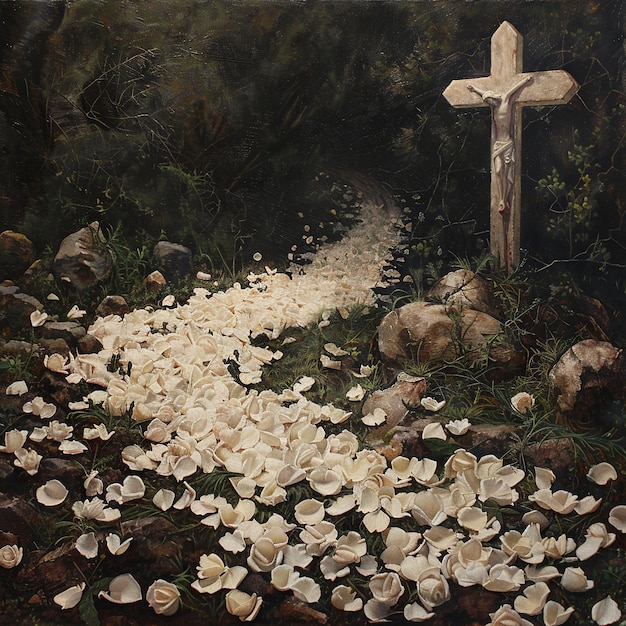Unveiling the Mystery of “A Burial at Ornans”: A Forgotten Masterpiece

“A Burial at Ornans” by Gustave Courbet, stands as a pivotal work in art history, challenging academic traditions with its realistic depiction of a common funeral, marking a significant shift towards Realism and influencing modern art.
Have you ever wondered about art that dared to break the mold? Gustave Courbet’s “A Burial at Ornans” shattered conventions, ushering in an era of Realism that continues to resonate today.
The Genesis of Realism: Courbet and “A Burial at Ornans”
Gustave Courbet, a rebellious spirit in the 19th-century art world, sought to depict life as it truly was, without romantic idealization or historical grandeur. “A Burial at Ornans” emerged as a bold statement against the prevailing academic norms, capturing the essence of everyday life with unflinching honesty.
Breaking with Tradition
Courbet’s artistic manifesto centered around direct observation and the portrayal of contemporary society. “A Burial at Ornans,” with its depiction of an ordinary funeral, challenged the established hierarchy of subject matter in art.
The Salon of 1850-51: A Turning Point
When “A Burial at Ornans” was exhibited at the Salon, it ignited controversy due to its unidealized representation of the middle class. This marked a turning point in art history, paving the way for Realism as a dominant movement.
- Realism’s Core Principles: Grounded in depicting subjects from direct observation.
- Social Commentary: Often included as an integral part of the narrative.
- Rejection of Idealization: Refusal to embellish reality for aesthetic purposes.
- Impact on Modern Art: Laid the foundation for future artistic movements focusing on authenticity.
The painting was not well received immediately, and the bold choice of subject matter resulted in harsh criticism and limited sale or fame for Courbet. But, in retrospect, the legacy is quite the opposite, with artists applauding the Realist masterpiece.
In conclusion, “A Burial at Ornans” launched Realism at the center of the Paris art scene, with Courbet’s painting as an artistic statement about the world being ripe with raw, unedited beauty, waiting to be put on a canvas.
Depicting the Mundane: The Composition and Subjects of “A Burial at Ornans”
Unlike paintings that highlighted nobility, kings or religious figures, Courbet’s choice of subject and composition was a deliberate move to show the essence of the common man. These are people that society did not deem worthy of memorializing until a painting like “A Burial at Ornans” came to life.
The Horizontal Format
The painting’s imposing size and horizontal format were traditionally reserved for historical or heroic scenes. By employing this format for a common burial, Courbet elevated the dignity of everyday life.
The Cast of Characters
Each of the figures in the painting, from the clergy to the grieving relatives, is rendered with individual characteristics and human flaws. This emphasis on individuality humanized the scene.
- Diverse Representation: Captures a wide array of human emotions and expressions.
- Honest Portrayal: Figures are depicted without idealization.
- Emphasis on Collective Experience: Focus on community and shared moments of grief.
Today it is easy to take for granted how impressive this type of art was, but at the time most art was made for the wealthy to flaunt and show off. People grew tired of the status quo to only enjoy art and this is where paintings like “A Burial at Ornans” really became culturally relevant.
Ultimately, the composition and subjects of “A Burial at Ornans” were groundbreaking in their time, capturing the essence of Realism by placing ordinary individuals and everyday life at the center of artistic attention.
The Scandalous Reception: Initial Reactions to Courbet’s Masterpiece
“A Burial at Ornans” was a polarizing piece that challenged the norms of the time. When it debuted as a work in progress, many were shocked the art was so massive and of such an “unimportant” scene to dedicate attention to.
Criticisms of Realism
Critics initially attacked the painting as ugly and lacking the aesthetic refinement of traditional art. They questioned the artistic merit of depicting such an unglamorous scene.
Misunderstandings of Courbet’s Intent
Many viewers failed to grasp Courbet’s intention to elevate the ordinary and celebrate the dignity of the working class. They saw it as an insult to artistic conventions.
The piece was very controversial and many people questioned Courbet and his artistic merit. Regardless, “A Burial at Ornans” has cemented itself in art history as a great example of Realism.
In conclusion, the scandalous reception of “A Burial at Ornans” was largely due to its challenge to established artistic conventions and its unflinching depiction of everyday life. Despite the initial criticism, the painting’s impact and significance have only grown over time.
Enduring Legacy: The Influence of “A Burial at Ornans” on Modern Art
Today, “A Burial at Ornans” is beloved for its honest portrayal of reality, which has had a lasting impact on the trajectory of modern art. Its rejection of romanticism paved the way for other artists to explore contemporary issues.
Paving the Way for Future Realists
Courbet’s work inspired a generation of artists to focus on portraying the world around them with honesty and authenticity. Realism became a dominant force in art.
Impacting Social and Political Art
“A Burial at Ornans” demonstrated the power of art to engage with social and political issues. This approach influenced artists who sought to make art that reflected the realities of their time.
- Emphasis on Social Consciousness: Encouraged artists to address social inequalities.
- Authenticity in Art: Inspired artists to depict subjects without embellishment or idealization.
- Art as a Reflection of Society: Established art as a critical voice and recorder of contemporary life.
Ultimately, “A Burial at Ornans” has had a transformative effect on modern painting in that it ushered in Realism and influenced artists for generations to come. It allowed them to capture the world in its raw form and tell stories that echoed the lives of everyday people.
In summary, the enduring legacy of “A Burial at Ornans” lies in its impact on modern and contemporary art. Which paved the way for artists to engage with the world as they saw it.
The Artistic Techniques: Courbet’s Approach to Realism in Detail
Focusing on more of Courbet’s techniques and unique approaches to create the painting, it is important to remember that his painting was less about the actual burial and more about the social aspects of the everyday.
Use of Light and Shadow
Courbet masterfully employed light and shadow to create depth and realism in his painting. His use of dramatic contrasts adds to the emotional intensity of the scene.
Brushwork and Texture
The artist’s thick, expressive brushstrokes contribute to the painting’s sense of immediacy and authenticity. The texture of the paint enhances the tactile quality of the artwork.
- Realistic Depiction of Form: Skillful use of light and shadow to model figures and objects.
- Emotional Depth: Brushwork emphasizes texture.
- Authenticity: Reinforces the painting’s raw and unfiltered representation.
In looking at “A Burial at Ornans,” one would never think so much work and technique would go into such a painting. However, Courbet was a visionary that used his medium to push limits and the message of the people.
To conclude, Courbet’s artistic techniques, particularly his use of light, shadow, brushwork, and color, are essential to understanding the impact and significance of “A Burial at Ornans.” These techniques worked well together to create realism in art.
The Setting: Ornans and Its Significance to Courbet
Ornans, the small town in which Courbet was born, held a special place in his heart. It served as the backdrop for some of his most important works and was where he honed his craft.
Roots in Rural France
Courbet’s connection to Ornans reflects his deep connection to the French countryside and his commitment to depicting the lives of rural people. This setting provided him with inspiration.
Local Authenticity
The town’s landscapes and community spirit provided a sense of authenticity to his art, which was very much needed in the realm of art at the time.
Courbet even involved members of his own inner circle like his family and friends, whom he hired for the project of painting “A Burial at Ornans.” The work was a way for him to celebrate his home town.
In summary, the setting of Ornans is integral to understanding Courbet’s artistic vision. Its influence helped create the legacy and meaning of “A Burial at Ornans” today.
| Key Aspect | Brief Description |
|---|---|
| 🎨 Realism | Depicts life as it is, challenging academic norms. |
| 👥 Subjects | Ordinary individuals elevated in a grand format. |
| 🏛️ Legacy | Inspired artists to engage with social and political issues. |
| 📍 Setting | Ornans provides local authenticity to the piece. |
Frequently Asked Questions
▼
Realism in art is a movement that began in the mid-19th century, aiming to portray subjects as they appear in everyday life. Realist artists reject romanticism and idealization, focusing instead on authentic and unembellished representations.
▼
“A Burial at Ornans” was controversial because it challenged the traditional academic norms and conventions of the time. Its unidealized portrayal of a common burial was seen as crude, and it was deemed ugly.
▼
Courbet’s techniques, such as his use of light, shadow, and expressive brushstrokes, had a profound influence on modern art. He paved the way for future Realists and artists who sought to depict the world around them with honesty and authenticity.
▼
Ornans, Courbet’s hometown, held great significance in his work. It became the backdrop for his rural pieces, which inspired a community spirit and captured a strong sense of authenticity.
▼
“A Burial at Ornans” became a notable piece in the social and political art arenas because it demonstrated how art could engage with social and political issues. As Courbet rejected romanticism, this impacted many artists.
Conclusion
“A Burial at Ornans” remains a cornerstone in art history, a symbol of Realism’s revolutionary spirit. It is a powerful testament to the beauty and dignity found in everyday life and how it can speak to a large audience that values family, friends and life itself.





